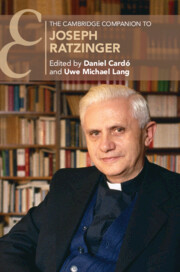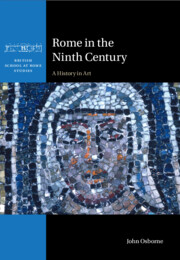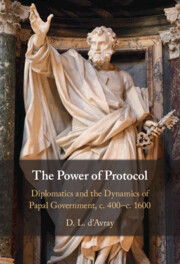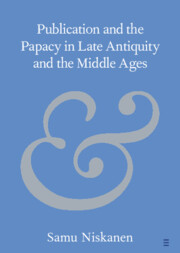53 results

The Cambridge Companion to Joseph Ratzinger
-
- Published online:
- 25 January 2024
- Print publication:
- 21 December 2023
Chapter 5 - Regibus solo nomine regnantibus: The Late Merovingians
- from Part III - Dogs and Lesser Beasts
-
- Book:
- The Merovingians in Historiographical Tradition
- Published online:
- 02 November 2023
- Print publication:
- 16 November 2023, pp 225-271
-
- Chapter
- Export citation

Rome in the Ninth Century
- A History in Art
-
- Published online:
- 10 October 2023
- Print publication:
- 12 October 2023

The Power of Protocol
- Diplomatics and the Dynamics of Papal Government, c. 400 – c.1600
-
- Published online:
- 20 July 2023
- Print publication:
- 10 August 2023
11 - The Emperor as Vogt, ca. 1000–1500
-
- Book:
- Corruption, Protection and Justice in Medieval Europe
- Published online:
- 12 October 2022
- Print publication:
- 24 November 2022, pp 234-253
-
- Chapter
- Export citation
7 - A History of Violence
-
- Book:
- Corruption, Protection and Justice in Medieval Europe
- Published online:
- 12 October 2022
- Print publication:
- 24 November 2022, pp 153-173
-
- Chapter
- Export citation
5 - The Limits of Church Reform
-
- Book:
- Corruption, Protection and Justice in Medieval Europe
- Published online:
- 12 October 2022
- Print publication:
- 24 November 2022, pp 108-129
-
- Chapter
- Export citation
8 - Weapons of the Not-So-Weak
-
- Book:
- Corruption, Protection and Justice in Medieval Europe
- Published online:
- 12 October 2022
- Print publication:
- 24 November 2022, pp 174-196
-
- Chapter
- Export citation
4 - Classical Rome to the Early Middle Ages
- from Part I - Psychology’s Historical Foundations
-
- Book:
- History and Systems of Psychology
- Published online:
- 04 November 2022
- Print publication:
- 17 November 2022, pp 59-86
-
- Chapter
- Export citation
5 - Reawakening of Intellectual Life in the Middle Ages
- from Part I - Psychology’s Historical Foundations
-
- Book:
- History and Systems of Psychology
- Published online:
- 04 November 2022
- Print publication:
- 17 November 2022, pp 87-107
-
- Chapter
- Export citation
Chapter 6 - The Royal Deathbed
- from Part II - Royal Childhood: Preparation for the Throne
-
- Book:
- Royal Childhood and Child Kingship
- Published online:
- 04 August 2022
- Print publication:
- 04 August 2022, pp 147-168
-
- Chapter
- Export citation
Chapter 6 - Introduction
- from Part III - The 11th and 12th Centuries
-
- Book:
- Introduction to Medieval Theology
- Published online:
- 15 April 2022
- Print publication:
- 24 March 2022, pp 77-82
-
- Chapter
- Export citation

Publication and the Papacy in Late Antiquity and the Middle Ages
-
- Published online:
- 13 December 2021
- Print publication:
- 20 January 2022
-
- Element
-
- You have access
- Open access
- HTML
- Export citation
4 - Foreign War
-
-
- Book:
- The Cambridge Companion to Shakespeare and War
- Published online:
- 17 August 2021
- Print publication:
- 14 October 2021, pp 54-74
-
- Chapter
- Export citation
7 - The Demise of the Senate
-
- Book:
- The Falls of Rome
- Published online:
- 04 September 2021
- Print publication:
- 09 September 2021, pp 300-336
-
- Chapter
- Export citation
1 - Approaches to the Fate of the Late Antique City
-
- Book:
- The Falls of Rome
- Published online:
- 04 September 2021
- Print publication:
- 09 September 2021, pp 1-35
-
- Chapter
- Export citation
7 - The Latin West
- from Part II - Historical Contexts
-
-
- Book:
- Political Culture in the Latin West, Byzantium and the Islamic World, c.700–c.1500
- Published online:
- 11 August 2021
- Print publication:
- 26 August 2021, pp 133-177
-
- Chapter
- Export citation
5 - The Congregation of the Propaganda Fide
-
- Book:
- The Holy Land and the Early Modern Reinvention of Catholicism
- Published online:
- 30 April 2021
- Print publication:
- 20 May 2021, pp 258-301
-
- Chapter
- Export citation
5 - God, Sovereignty, and the Morality of Intervention outside Europe
-
-
- Book:
- Christianity and International Law
- Published online:
- 17 May 2021
- Print publication:
- 20 May 2021, pp 91-114
-
- Chapter
- Export citation
4 - Formation and Refiguration of the Canon Law on Trade with Infidels (c.1200–c.1600)
-
-
- Book:
- Christianity and International Law
- Published online:
- 17 May 2021
- Print publication:
- 20 May 2021, pp 59-90
-
- Chapter
- Export citation



